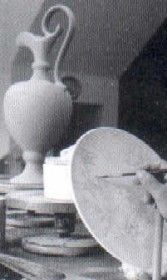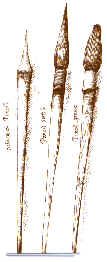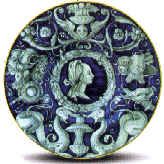The ceramics of Casteldurante
The ceramics of Casteldurante (Urbania since 1636 in honour of Urbano VIII)
was already present in the medieval period. In the XVIth century reached a
very high qualitative fluorishing level, increased by “Raphaelism” and by
the influence of painters, poets , and humanists of the Renaissance Court,
Casteldurante also benefitted from the affluent conditions of the Duchy of
Urbino during the domination of the Montefeltros and the Della Roveres. At
about the middle of XVIth century, Casteldurance together with Urbino,
Pesaro and other centres of the “metaurense” area in the Marches, produced
some of the most beautiful majolicas of the Renaissance distinguishable from
those of Faenza and others Italian places of majolica by the invention of
typical decorations and the
refinement
of
the narrative pictorial genre called “istoriata” (decorated
with scenes). At this time, in Casteldurante, which
lies
on
the banks of the Metauro river,
over
40 klins were working for
all the Eurapean Courts,
and in the census were included 150 makers
of
majolica
ware, among
which there were turners and painters
of
extraordinary
ability in decoration
and drawings (Zoan
Maria, Simone
da Colonello,
the Dolcis,
the Fontanas,
etc.).
At the same time
several
masters left their town,
taking their
art to
other
parts of
Italy, Northen
Europe
and abroad.
About
1540, the
“durantino”
(inhabitant of
Casteldurante) Cipriano
Piccolpasso,
the unique master of
Italian Renaissance ceramics, wrote
his treatise ‘The
three books
of
the potter’s
art” in which he taught the
secrets and the rules
of
making ceramics (today
the volume
is preserved in the Victoria
and Albert Museum of
London).
The heritage of
knowledge
of
the ancient masters has been handed down
during the centuries: today,
we can find skillful ceramists, both
professional
and amateur, working
in Urbania and in their workshops
the colours,
the techniques and the extraordinary
richness of
the vases and “istoriato”
plates of
the past, still
live
on.
Exhibition
sections
The ceramics of
Casteldurante produced today by the local
workshops according ancient methods:
various
types of
ceramics from
the area of
Urbino
and the river Metauro
between XVIth and XVIIth
centuries are on
show.
“The three books of the
potter’s art” by Cipriano Piccolpasso:
Reproductions
of
making ceramic from
Piccolpasso’s
books,
together
with photographs
of
some
important
examples of
ceramics of
the
Renaissance of
Casteldurante.
The teaching of
majolica:
Clay- moulding-
firing- enamellingdecoration-
crystallisation
process
- second
firing - finished majolica.
Moulding experience:
A turner will
create live
antique shapes of
the ceramics of
Casteldurante.
Historical- geographical
itinerary:
The places and the
movement of majolica.
The places of ceramics: Urbania, the ancient
Casteldurante of majolicas



